Moonflower (Moon vine, thorn apple, tropical white morning-glory, jimsonweed, evening glory) is a large and highly fragrant self-seeding plant originated to South and Central America. When the night comes, its white petals unfurl, and you can enjoy lovely, white, fragrant blooms until morning arrives.
In the 19th century, people organized night parties to have an opportunity to enjoy the fragrant, nocturnal blooms of this flower. Even today, when you give someone a Moonflower, you send a message about ‘dreaming of love.’
Lovely Moonflower

The genus name (Ipomoea Alba) of this plant comes from the Greek words ‘ips,’ which means – worm and ‘homoios,’ which means – resembling. If you know that ‘alba’ means – white, you can conclude that the name of this flower references to the color of blooms and the way underground roots sprawl.
You can grow Moonflower as a hardy plant if you live in a warm region, but it is just an annual cultivar in the States with a cold climate.
This vining plant grows fast and can reach incredible 12-18 feet (3.6 – 5.5 m) in a single year. Therefore, you should support it with a trellis or fence. In tropics, it can reach fantastic 70 feet (21 m) height.
With the 6 inches (15 cm) long trumpet-shaped flowers and large, heart-shaped foliage, Moonflower is one of the most beautiful plants you can grow in your garden.
Plus, you will adore deep-green, 4 to 8 inches (10 – 20 cm) long leaves arranged on the milky-juiced, prickly stems.
I can highly recommend my favorite varieties of Moonflower and hope that you will love them as I do. If you choose ‘Blackcurrant Swirl,’ you will get a plant with double purple blooms arranged on the 5 feet (1.5 m) tall stem. On the other hand, there is a 4 feet (1.2 m) tall ‘Evening Fragrance,’ with marvelous pure-white flowers.
One more thing! These fantastic plants don’t bloom during the night without reason. It is necessary because their pollinators are night-flying insects, including the most important hawk moth. That means that the plant opens flowers at the moment when these insects are the most active.
Toxicity of Moonflower

It is not very clear how toxic Moonflower is. It seems that some species are more poisonous than others. However, keep your children and pets far away from this plant, and take care to prevent ingestion.
For example, Ipomoea Alba has just local effects and causes a skin rash. On the other hand, Datura Inoxia is highly toxic because containing dangerous atropine, hyoscyamine, and scopolamine.
How to Plant Moonflower in Your Garden
Propagating this beautiful plant is not a big deal at all. You can easily do it by yourself after deciding which way of planting fits you the most, and which variation of flower you prefer.
Propagating by seedlings

Since Moonflower is a perennial, you can propagate it by seedlings. Purchase some in a garden center or local nursery. You can also cut off vines from your own plant to an approximate length of 4 to 6 inches (10 – 15 cm) in late summer.
Defoliate seedlings by half and plant them approximately 0.2 inches (0.5 cm) deep in pots filled with a mix of standard soil and sand. Place them at the half-shady window spot and provide the temperatures of 50 to 70 F (10 – 21 C) until the middle of May.
When spring comes, you should transplant seedlings in the garden and water them regularly until establishing. Don’t fertilize young plants in this stage, but you should add a layer of mulch to keep the moisture in the ground and prevent the growth of weeds.
Propagation by seeds

If you prefer growing Moonflower from your own seeds, you can do it without much effort. Leave some flowers on the stem after withering and let them transform into ball-like fruits full of seeds.
Dry fertile seed stems, and store them in a dark place throughout winter. When spring comes, soak seeds in a glass full of warm water for about 4 to 8 hours before planting. That way, you will help them germinate and increase the rate of germination.
You should plant your seeds 0.25 inches (0.6 cm) deep in a pot a month before the temperatures become at least 50 F (10 C) at night. Keep them indoors in full sun and keep the ground moist. The process of germination lasts approximately 5 to 10 days.
After the last frost, it is the time to transplant new seedlings into the garden. Space them at least 6 inches (15 cm) apart to provide necessary air circulation.
You can also sow seeds directly in the garden after the last frost. If the temperatures are from 65 to 85 F (18 – 29.5 C), they will germinate and grow quickly.
Planting in a bed

You can use Moonflower for making garden fences or hide ugly facades, sheds, or water pipes. Prepare beds properly, plant your flowers there, and beautify every problematic part of your yard.
Use a garden rake to prepare the right spot. Soak root bales in a bowl with water until you see first bubbles. Then dig up a hole, which is about 50% wider than the root ball, and plant seedlings approximately 12 to 20 inches (30.5 – 51 cm) apart.
Add horn shavings and sieved compost into the prepared hole, press the earth around seedlings slightly, and water them generously.
How to Care Moonflower in Your Garden
Soil
Your Moonflower will grow vigorous and healthy, no matter which type of ground you have in your garden. However, you will get the best from this plant if you provide the fertile, well-drained, loam soil rich in nutrients.
If the drainage in your garden is not adequate, you can solve the problem by adding a thick layer of well-rotted compost. It will loosen the ground, improve its permeability, and add necessary nutrients for better growth.
If you decide to grow Moonflower in a basket or pot, you should add some high-quality potting soil for productive cultivation. By adding sand, lava granulates, or perlite to the bottom of the basket, you will improve the drainage of the ground.
Light
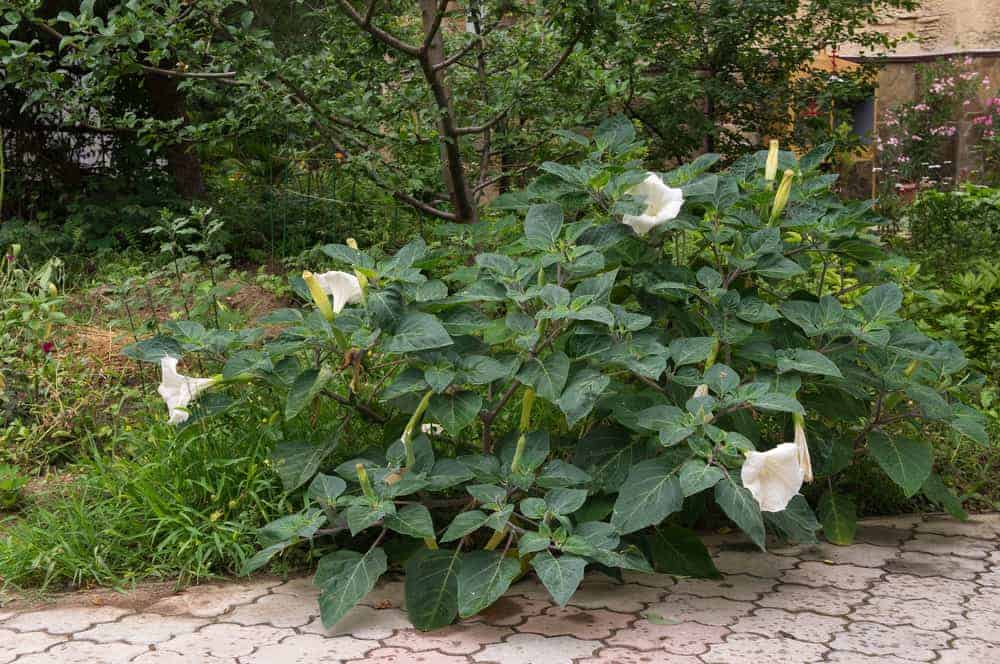
Even though Moonflower can tolerate part shade, you should plant it in full sun if you want to get the best flourishing. Avoid planting it on the side of the buildings which block the sunshine for much of the day.
Temperatures

Since Moonflower is a tropical flower, it is quite easy growing it in warm regions. In fact, this plant prefers high temperatures and humidity. You can grow it even in colder parts of the country as an annual while the temperatures are 60 to 70 F (15. 5 – 21 C).
In the US, Moonflower is a native flower to Florida, Texas, and Louisiana, but you can grow it in Hawaii as well. On the other hand, this plant is considered invasive, noxious weeds in Arizona and Arkansas.
Watering
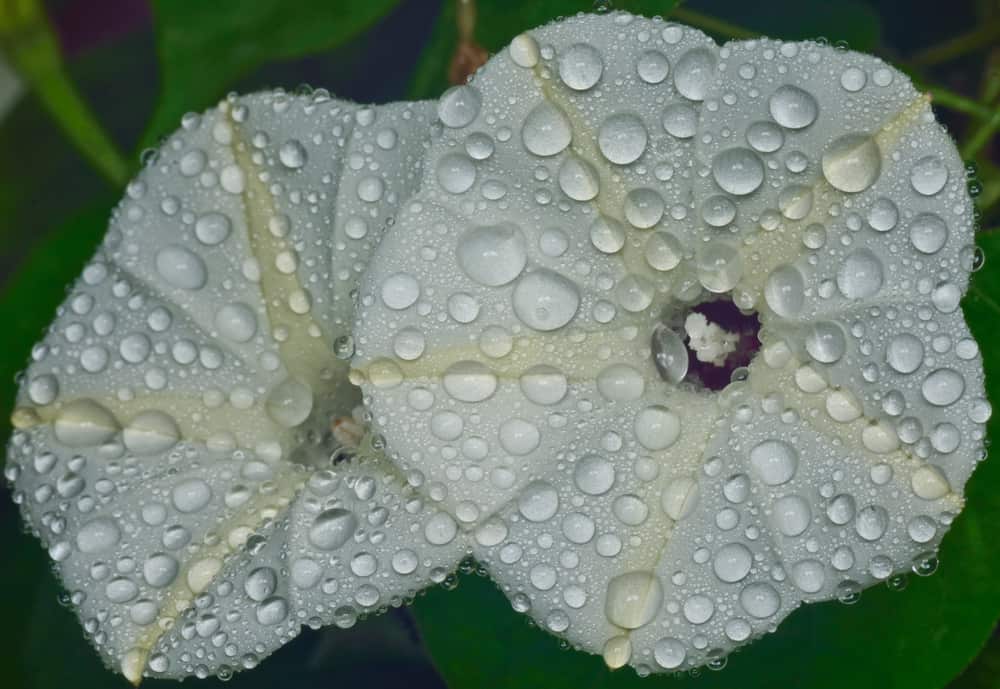
When we are talking about this plant, the essential part of maintenance is watering. If the soil is moist enough, your plant will bloom abundantly and produce the fantastic, lush foliage.
Pay special attention to a young plant until establishing. It will need approximately 1 inch (2.5 cm) of water a week, especially in summer.
As soon as the surface of the ground dries, you should grab the garden watering can and water your plant. However, be careful. If you spray leaves during watering, you will expose this flower to the risk of a fungal infection.
Stop watering during the rainy days to avoid waterlogging and consequential root rot. When the days are hot and sunny, water your Moonflower deeply once to twice a week.
Fertilizing
Feed your plant regularly during a blooming season. The best option is fertilizer high in phosphorus, but you should avoid those with a high level of nitrogen. Your goal is to promote flourishing, not lush foliage.
In general, it is better avoiding fertilizing Moonflower while producing flowers than adding the wrong one and suppressing flourishing. An excellent solution is applying a bit of liquid fertilizer weekly. Don’t forget to water your plant generously at the end.
Mulching

Adding mulch around your plant will help in keeping the ground adequately moist and weed-free.
Supporting

This vining plant will need some support, especially in cases when it grows too lush. In that case, you can use a trellis as the ideal support for too heavy stems.
Let the plant climbs freely, and you will get an amazing part of your garden full of wide-open, fragrant flowers every single night.
Pruning

Moonflower is prone to grow too lush. Therefore, you should keep its appearance under control by regular cutting of withered flowers. That will definitely encourage the healthy growth of side shoots.
Every pruning the shoot tips will force the plant to grow to the side, not just in height. The result will be a visually acceptable growth full of fantastic blossoms.
Moonflower Pests and Diseases
Nutrient deficiency

If the soil in your garden is deficient in nitrogen, iron, manganese, or zinc, you will notice yellowing of the foliage.
You can determine which of these elements miss since the young leaves will change first if there is not enough iron. When there is a deficit in nitrogen, zinc, or manganese in the ground, you will notice the first deficiency symptoms on the older foliage.
However, the soil may be rich in essential nutrients, but your plant can’t use them. It happens when pH is too high, or an excess of other chemicals make them unavailable.
Exposure to prolonged drought
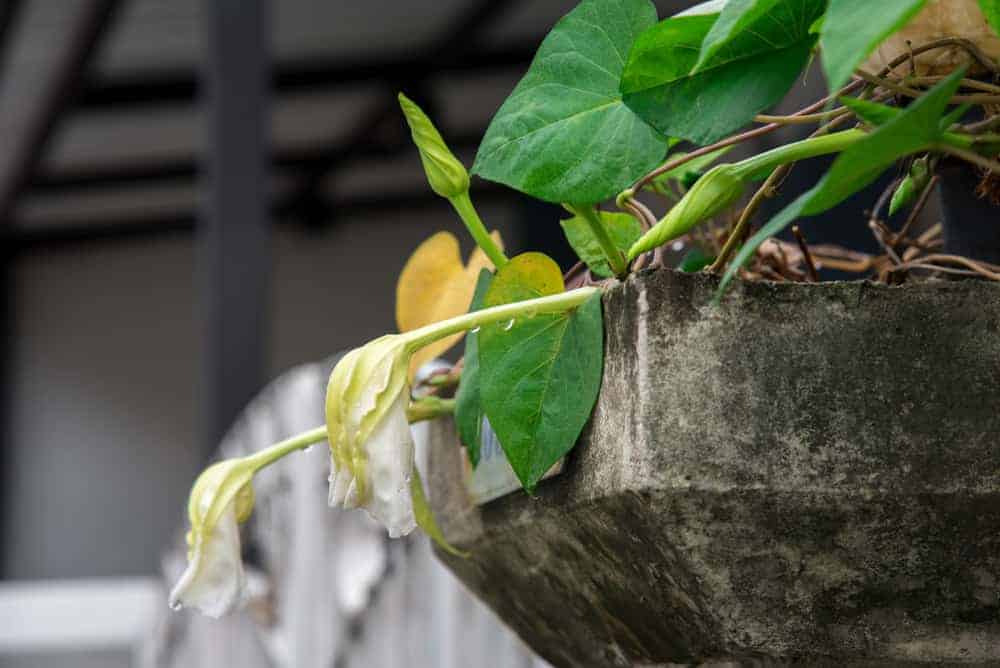
When your plant is not watered adequately, its leaves will become wilted and brown. At the same time, the growth of Moonflower will slow down, and it will produce fewer leaves.
Prevent this issue by watering your flower with at least 1 inch (2.5 cm) of water a week. Also, proper mulching will prevent evaporation and keep the ground moist.
Chlorosis
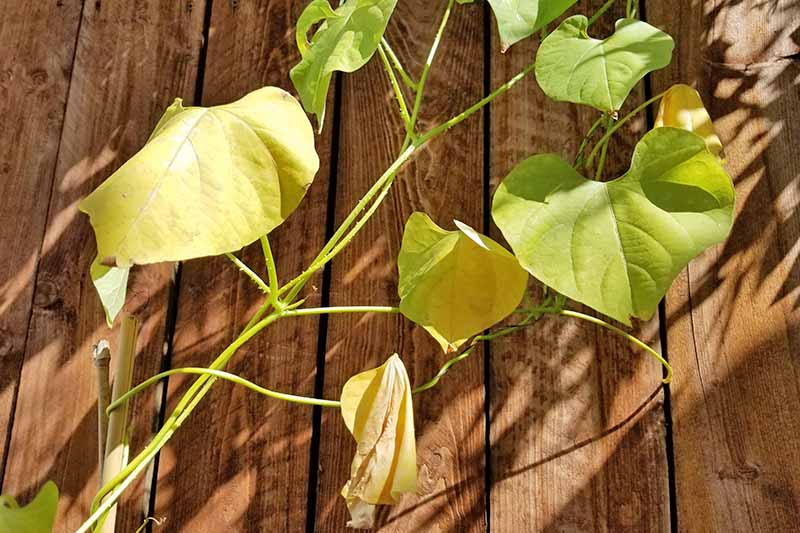
The lack of chlorophyll will cause abnormally yellow leaves. The reason can be damaged roots, which will prevent regular feeding of the plant. Also, the problem can be too alkaline soil or inadequate drainage.
Black rot

This is a bacterial disease attacking leaves in a period when the temperatures and humidity are too high. You can see yellow-orange V-shaped lesions on the foliage’ edges.
After a while, leaves will dry out and fall off. Prevent this condition by crop rotation as well as proper air circulation and watering.
Rust
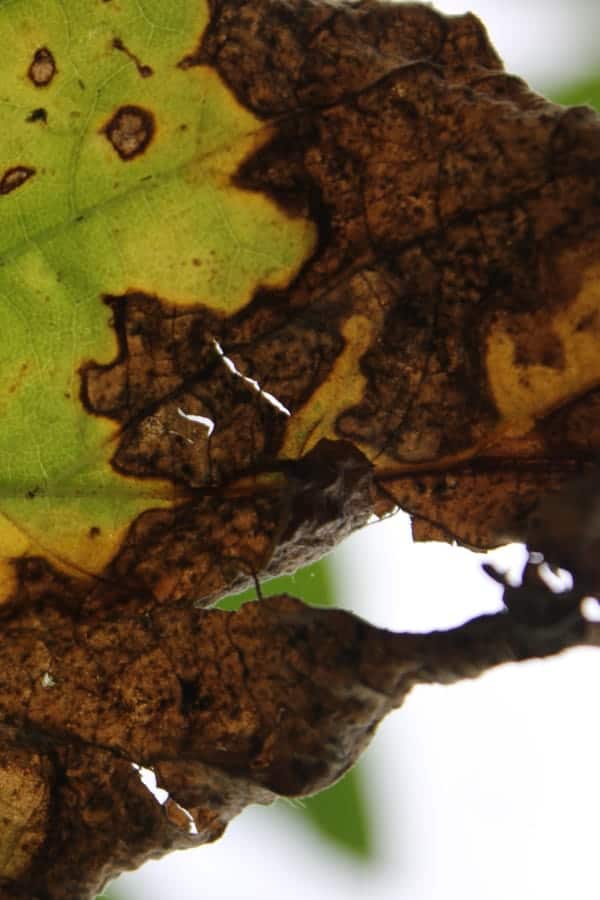
The reason for this condition are fungi, which will damage the leaves of your plant and cause rust-colored spots on them. If this issue appears, the only thing you can do is to destroy affected plants.
Stem canker
When fungi occur, they will damage stems, which become brown and wilt. The best solution is to remove infected parts of the plant as soon as noticing the first symptoms. Prevent this problem by crop rotation. Plus, avoid sprinkling the foliage while watering.

My mother had what she considers to be an unsightly feature at the edge of her garden, a large number of electrical wires going diagonally from the nearest pole into the ground between the sidewalk and the street. To make matters worse they came and put an ugly grey plastic tube around some of the wires. So she planted moonflowers from a cutting she got from a neighbor. Despite being in central NY where it’s very cold in the winter and contrary to the conventional wisdom, the moonflowers flourished and they come back on their own every year! This plant is actually more hardy in the cold than some people think! The flowers are a beautiful white, but I don’t know the exact species she planted.